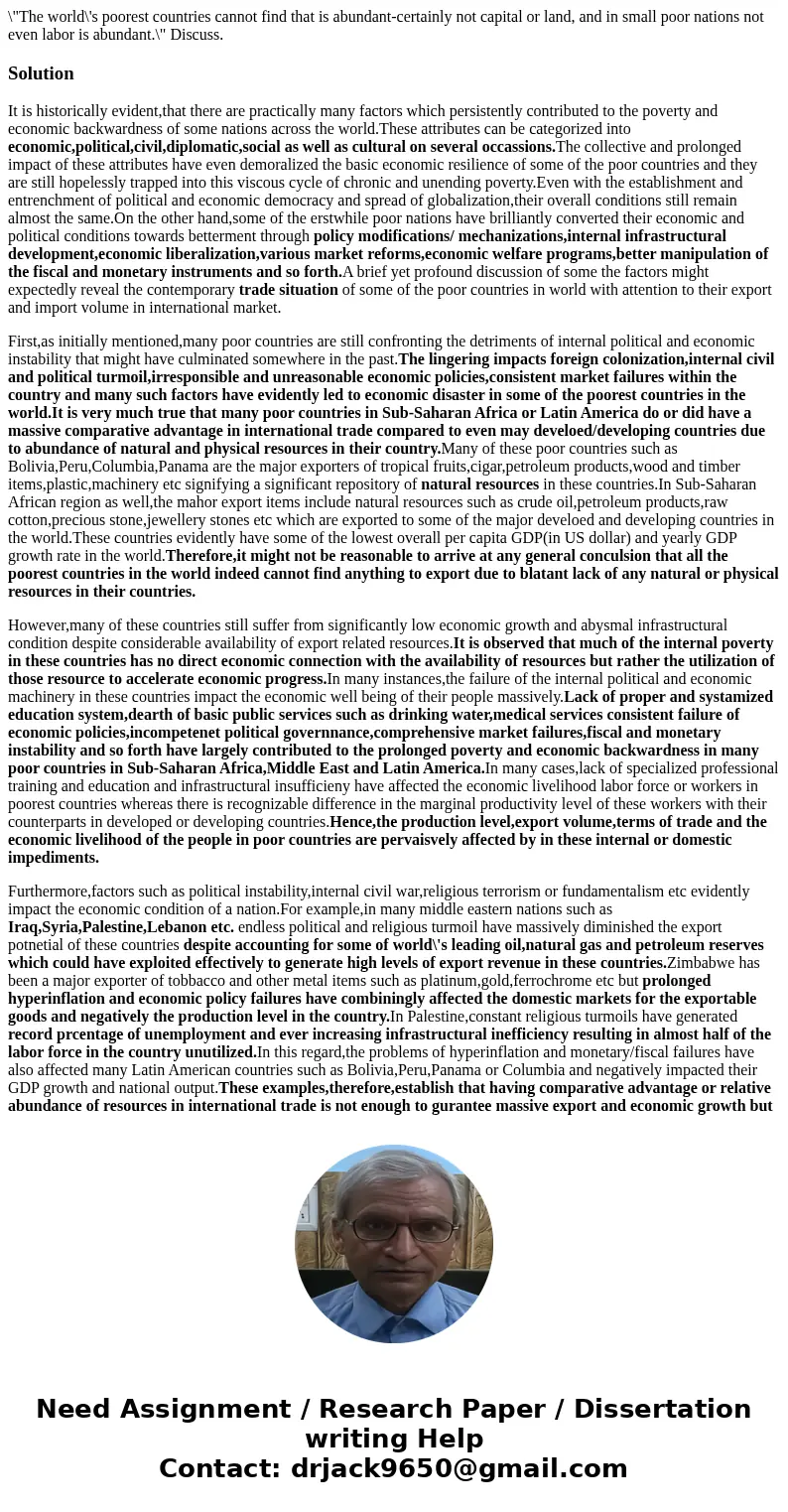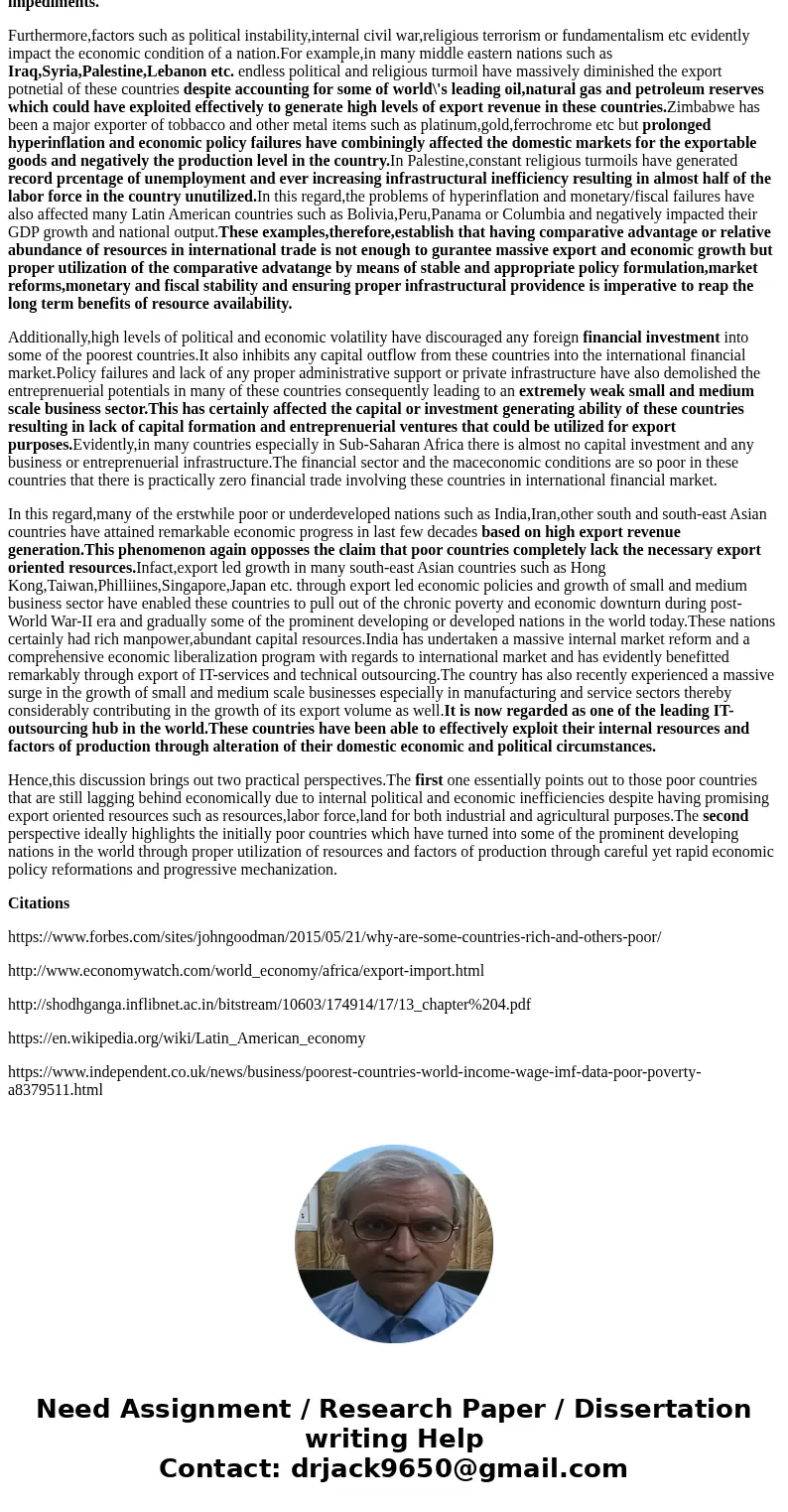The worlds poorest countries cannot find that is abundantcer
Solution
It is historically evident,that there are practically many factors which persistently contributed to the poverty and economic backwardness of some nations across the world.These attributes can be categorized into economic,political,civil,diplomatic,social as well as cultural on several occassions.The collective and prolonged impact of these attributes have even demoralized the basic economic resilience of some of the poor countries and they are still hopelessly trapped into this viscous cycle of chronic and unending poverty.Even with the establishment and entrenchment of political and economic democracy and spread of globalization,their overall conditions still remain almost the same.On the other hand,some of the erstwhile poor nations have brilliantly converted their economic and political conditions towards betterment through policy modifications/ mechanizations,internal infrastructural development,economic liberalization,various market reforms,economic welfare programs,better manipulation of the fiscal and monetary instruments and so forth.A brief yet profound discussion of some the factors might expectedly reveal the contemporary trade situation of some of the poor countries in world with attention to their export and import volume in international market.
First,as initially mentioned,many poor countries are still confronting the detriments of internal political and economic instability that might have culminated somewhere in the past.The lingering impacts foreign colonization,internal civil and political turmoil,irresponsible and unreasonable economic policies,consistent market failures within the country and many such factors have evidently led to economic disaster in some of the poorest countries in the world.It is very much true that many poor countries in Sub-Saharan Africa or Latin America do or did have a massive comparative advantage in international trade compared to even may develoed/developing countries due to abundance of natural and physical resources in their country.Many of these poor countries such as Bolivia,Peru,Columbia,Panama are the major exporters of tropical fruits,cigar,petroleum products,wood and timber items,plastic,machinery etc signifying a significant repository of natural resources in these countries.In Sub-Saharan African region as well,the mahor export items include natural resources such as crude oil,petroleum products,raw cotton,precious stone,jewellery stones etc which are exported to some of the major develoed and developing countries in the world.These countries evidently have some of the lowest overall per capita GDP(in US dollar) and yearly GDP growth rate in the world.Therefore,it might not be reasonable to arrive at any general conculsion that all the poorest countries in the world indeed cannot find anything to export due to blatant lack of any natural or physical resources in their countries.
However,many of these countries still suffer from significantly low economic growth and abysmal infrastructural condition despite considerable availability of export related resources.It is observed that much of the internal poverty in these countries has no direct economic connection with the availability of resources but rather the utilization of those resource to accelerate economic progress.In many instances,the failure of the internal political and economic machinery in these countries impact the economic well being of their people massively.Lack of proper and systamized education system,dearth of basic public services such as drinking water,medical services consistent failure of economic policies,incompetenet political governnance,comprehensive market failures,fiscal and monetary instability and so forth have largely contributed to the prolonged poverty and economic backwardness in many poor countries in Sub-Saharan Africa,Middle East and Latin America.In many cases,lack of specialized professional training and education and infrastructural insufficieny have affected the economic livelihood labor force or workers in poorest countries whereas there is recognizable difference in the marginal productivity level of these workers with their counterparts in developed or developing countries.Hence,the production level,export volume,terms of trade and the economic livelihood of the people in poor countries are pervaisvely affected by in these internal or domestic impediments.
Furthermore,factors such as political instability,internal civil war,religious terrorism or fundamentalism etc evidently impact the economic condition of a nation.For example,in many middle eastern nations such as Iraq,Syria,Palestine,Lebanon etc. endless political and religious turmoil have massively diminished the export potnetial of these countries despite accounting for some of world\'s leading oil,natural gas and petroleum reserves which could have exploited effectively to generate high levels of export revenue in these countries.Zimbabwe has been a major exporter of tobbacco and other metal items such as platinum,gold,ferrochrome etc but prolonged hyperinflation and economic policy failures have combiningly affected the domestic markets for the exportable goods and negatively the production level in the country.In Palestine,constant religious turmoils have generated record prcentage of unemployment and ever increasing infrastructural inefficiency resulting in almost half of the labor force in the country unutilized.In this regard,the problems of hyperinflation and monetary/fiscal failures have also affected many Latin American countries such as Bolivia,Peru,Panama or Columbia and negatively impacted their GDP growth and national output.These examples,therefore,establish that having comparative advantage or relative abundance of resources in international trade is not enough to gurantee massive export and economic growth but proper utilization of the comparative advatange by means of stable and appropriate policy formulation,market reforms,monetary and fiscal stability and ensuring proper infrastructural providence is imperative to reap the long term benefits of resource availability.
Additionally,high levels of political and economic volatility have discouraged any foreign financial investment into some of the poorest countries.It also inhibits any capital outflow from these countries into the international financial market.Policy failures and lack of any proper administrative support or private infrastructure have also demolished the entreprenuerial potentials in many of these countries consequently leading to an extremely weak small and medium scale business sector.This has certainly affected the capital or investment generating ability of these countries resulting in lack of capital formation and entreprenuerial ventures that could be utilized for export purposes.Evidently,in many countries especially in Sub-Saharan Africa there is almost no capital investment and any business or entreprenuerial infrastructure.The financial sector and the maceconomic conditions are so poor in these countries that there is practically zero financial trade involving these countries in international financial market.
In this regard,many of the erstwhile poor or underdeveloped nations such as India,Iran,other south and south-east Asian countries have attained remarkable economic progress in last few decades based on high export revenue generation.This phenomenon again opposses the claim that poor countries completely lack the necessary export oriented resources.Infact,export led growth in many south-east Asian countries such as Hong Kong,Taiwan,Philliines,Singapore,Japan etc. through export led economic policies and growth of small and medium business sector have enabled these countries to pull out of the chronic poverty and economic downturn during post-World War-II era and gradually some of the prominent developing or developed nations in the world today.These nations certainly had rich manpower,abundant capital resources.India has undertaken a massive internal market reform and a comprehensive economic liberalization program with regards to international market and has evidently benefitted remarkably through export of IT-services and technical outsourcing.The country has also recently experienced a massive surge in the growth of small and medium scale businesses especially in manufacturing and service sectors thereby considerably contributing in the growth of its export volume as well.It is now regarded as one of the leading IT-outsourcing hub in the world.These countries have been able to effectively exploit their internal resources and factors of production through alteration of their domestic economic and political circumstances.
Hence,this discussion brings out two practical perspectives.The first one essentially points out to those poor countries that are still lagging behind economically due to internal political and economic inefficiencies despite having promising export oriented resources such as resources,labor force,land for both industrial and agricultural purposes.The second perspective ideally highlights the initially poor countries which have turned into some of the prominent developing nations in the world through proper utilization of resources and factors of production through careful yet rapid economic policy reformations and progressive mechanization.
Citations
https://www.forbes.com/sites/johngoodman/2015/05/21/why-are-some-countries-rich-and-others-poor/
http://www.economywatch.com/world_economy/africa/export-import.html
http://shodhganga.inflibnet.ac.in/bitstream/10603/174914/17/13_chapter%204.pdf
https://en.wikipedia.org/wiki/Latin_American_economy
https://www.independent.co.uk/news/business/poorest-countries-world-income-wage-imf-data-poor-poverty-a8379511.html


 Homework Sourse
Homework Sourse